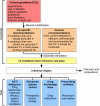How to translate therapeutic recommendations in clinical practice guidelines into rules for critiquing physician prescriptions? Methods and application to five guidelines
- PMID: 20509903
- PMCID: PMC2893080
- DOI: 10.1186/1472-6947-10-31
How to translate therapeutic recommendations in clinical practice guidelines into rules for critiquing physician prescriptions? Methods and application to five guidelines
Abstract
Background: Clinical practice guidelines give recommendations about what to do in various medical situations, including therapeutical recommendations for drug prescription. An effective way to computerize these recommendations is to design critiquing decision support systems, i.e. systems that criticize the physician's prescription when it does not conform to the guidelines. These systems are commonly based on a list of "if conditions then criticism" rules. However, writing these rules from the guidelines is not a trivial task. The objective of this article is to propose methods that (1) simplify the implementation of guidelines' therapeutical recommendations in critiquing systems by automatically translating structured therapeutical recommendations into a list of "if conditions then criticize" rules, and (2) can generate an appropriate textual label to explain to the physician why his/her prescription is not recommended.
Methods: We worked on the therapeutic recommendations in five clinical practice guidelines concerning chronic diseases related to the management of cardiovascular risk. We evaluated the system using a test base of more than 2000 cases.
Results: Algorithms for automatically translating therapeutical recommendations into "if conditions then criticize" rules are presented. Eight generic recommendations are also proposed; they are guideline-independent, and can be used as default behaviour for handling various situations that are usually implicit in the guidelines, such as decreasing the dose of a poorly tolerated drug. Finally, we provide models and methods for generating a human-readable textual critique. The system was successfully evaluated on the test base.
Conclusion: We show that it is possible to criticize physicians' prescriptions starting from a structured clinical guideline, and to provide clear explanations. We are now planning a randomized clinical trial to evaluate the impact of the system on practices.
Figures




References
-
- Dufour J, Bouvenot J, Ambrosi P, Fieschi D, Fieschi M. Proc AMIA Symp. Washington, DC; 2006. Textual Guidelines versus Computable Guidelines: A Comparative Study in the Framework of the PRESGUID Project in Order to Appreciate the Impact of Guideline Format on Physician Compliance; pp. 219–223. - PMC - PubMed
-
- Perria C, Mandolini D, Guerrera C, Jefferson T, Billi P, Calzini V, Fiorillo A, Grasso G, Leotta S, Marrocco W, Suraci C, Pasquarella A. Implementing a guideline for the treatment of type 2 diabetics: results of a Cluster-Randomized Controlled Trial (C-RCT) BMC Health Services Research. 2007;7:79. doi: 10.1186/1472-6963-7-79. - DOI - PMC - PubMed
MeSH terms
LinkOut - more resources
Full Text Sources
Other Literature Sources
Molecular Biology Databases

